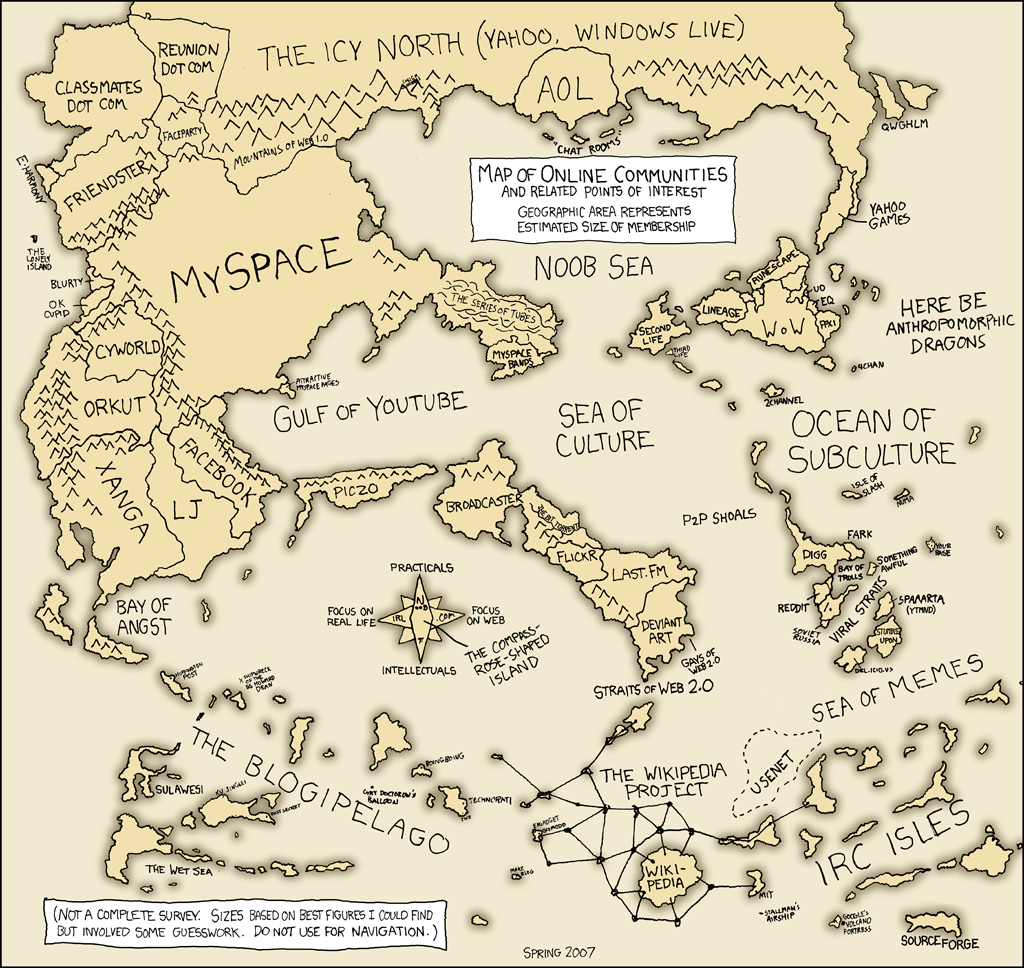
Rhizome
Implies everything is geographically linked so while anything can connect to anything else, once it is connected it is there.
Paul: everything is all connected to everything else but if something gets broken it is already reset that it will reform. Why can't the connections stop, why are there no dead-ends?
Andy: for something to exist it must be connected.
Andrew: the problem is once you bring in a structure how do you talk about rhizomes?
Read: The Logic of Sense: Deleuze on Lewis Carroll
Can't bring conventional logic to come to bear on this model of rhizome
Paul: Not only does all information exist in the same place at the same time, but is equally accessible from any point. There is no sense that you can go back.
Andrew: ides that you can do "derive" - unstructured wandering, directed in an undirected way like walking around Paris with a map from Berlin, strategies to remove all sense of culture. The idea was to remove valued of art and culture. Repetition and difference all the time.
CONTEXT: This is a vision of a world (before computers)
Provides a conceptual model
Niecthze - his ideas were taken and then rewritten by the Nazis, it was taken up because one of his key notions was: "God is dead." Nightmareish vision of the world because God once was... He
 saw Wagner as an Übermensch. In his wake come important ideas like good and evil being subjective rather than absolutes.
saw Wagner as an Übermensch. In his wake come important ideas like good and evil being subjective rather than absolutes.Another idea is that all human's are driven by one's desire to have power, to overcome and be superior to.
Deleuze picks up on these ideas, reinterprets them, he is addressing these concepts. He is trying to negate most of them. The notion of the will to power is something that Deleuze critiques. For him, the world should be a flat or horizontal structure, you cannot rise above. That actually in a rhizomatic world, everything is equivalent, remaining a nomad and changing your point of view.
You're in a perpetual state of becoming, you are constantly in transit. Fits as a metaphor for the internet age. You are all equivalent, your computer is either online or offline.
The importance of a social desire. He says there is no distinction between the individual desire and social world, we are simply an expression of a larger social consciousness. Highly post-Marxist reading of the world, anti-individualist. Interesting from the perspective on web 2.0. We make everythign configurable to what we like (think amazon, ebay home page etc...) but Deleuze would say that it isn't really an individual choice but what society desires.
Jess: So wonder how Deleuze would see the long tail? There is only the long tail, we are all on the horizontal line. Anything vertical is redundant/hierarchical.
Extremely radical ideas.
Their idea is creative and different for philosophy, you can always move on and find something different. And empowering for the individual no matter who you are.
Andy: thinking about everything being connected...there are online archives in which you can get back to the past.
The idea of a library, and dictionary is about keeping in the good words and keeping out the bad words but really all words are equivalent.
Andy: Redgreen theory of evolution - idea is from looking glass, you have to run as fast as you can to be whoever you are, to kep the same positions: like constantly becoming.
Andrew: Old movies there are those old wagon wheels, but they appear to be static because the frame rate and actual rate differ.
Andy: also looking at car wheels turning, the appear to go backwards.
Paul: Indicator of change - playing Halo with friends over the internet ends up being a nice way to have a conversation...
XKCD - maps of online communities

Digital interpretation of is God Dead?:
This is also an example of manipulating a platform rather than creating it (like in Second Life)
Andy: technology is a generational thing
Paul and Jess: no!!!
Paul: one of the important changes is that technology seems to be more accessible, everyone has a tv
Convergence!!!
Usage will change. So people who might not have been interested in taking photos could start developing an interest because their new mobile has a camera.
Andrew: This convergence of technology could have existed some time ago. Because of how the market works etc...there is an incremental change.
One of the most interesting developments in creative technologies is the way they are used is not necessarily what it was made for (think of text messaging)
Have a look at Howard Rheingold's Smart Mobs (back to Deleuze's social desire).






